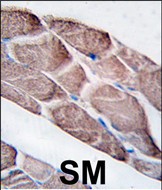EPM2A Antibody (C-term)
Purified Rabbit Polyclonal Antibody (Pab)
- 产品详情
- 实验流程
- 背景知识
Application
| WB, IHC-P, E |
|---|---|
| Primary Accession | O95278 |
| Reactivity | Human |
| Host | Rabbit |
| Clonality | Polyclonal |
| Isotype | Rabbit IgG |
| Calculated MW | 37158 Da |
| Antigen Region | 288-317 aa |
| Gene ID | 7957 |
|---|---|
| Other Names | Laforin, 313-, Glucan phosphatase, Lafora PTPase, LAFPTPase, EPM2A |
| Target/Specificity | This EPM2A antibody is generated from rabbits immunized with a KLH conjugated synthetic peptide between 288-317 amino acids from the C-terminal region of human EPM2A. |
| Dilution | WB~~1:1000 IHC-P~~1:100~500 E~~Use at an assay dependent concentration. |
| Format | Purified polyclonal antibody supplied in PBS with 0.09% (W/V) sodium azide. This antibody is prepared by Saturated Ammonium Sulfate (SAS) precipitation followed by dialysis against PBS. |
| Storage | Maintain refrigerated at 2-8°C for up to 2 weeks. For long term storage store at -20°C in small aliquots to prevent freeze-thaw cycles. |
| Precautions | EPM2A Antibody (C-term) is for research use only and not for use in diagnostic or therapeutic procedures. |
| Name | EPM2A |
|---|---|
| Function | Plays an important role in preventing glycogen hyperphosphorylation and the formation of insoluble aggregates, via its activity as glycogen phosphatase, and by promoting the ubiquitination of proteins involved in glycogen metabolism via its interaction with the E3 ubiquitin ligase NHLRC1/malin. Shows strong phosphatase activity towards complex carbohydrates in vitro, avoiding glycogen hyperphosphorylation which is associated with reduced branching and formation of insoluble aggregates (PubMed:16901901, PubMed:23922729, PubMed:25538239, PubMed:25544560, PubMed:26231210). Dephosphorylates phosphotyrosine and synthetic substrates, such as para- nitrophenylphosphate (pNPP), and has low activity with phosphoserine and phosphothreonine substrates (in vitro) (PubMed:11001928, PubMed:11220751, PubMed:11739371, PubMed:14532330, PubMed:14722920, PubMed:16971387, PubMed:18617530, PubMed:22036712, PubMed:23922729). Has been shown to dephosphorylate MAPT (By similarity). Forms a complex with NHLRC1/malin and HSP70, which suppresses the cellular toxicity of misfolded proteins by promoting their degradation through the ubiquitin-proteasome system (UPS). Acts as a scaffold protein to facilitate PPP1R3C/PTG ubiquitination by NHLRC1/malin (PubMed:23922729). Also promotes proteasome-independent protein degradation through the macroautophagy pathway (PubMed:20453062). |
| Cellular Location | Cytoplasm. Note=Under glycogenolytic conditions localizes to the nucleus [Isoform 2]: Cytoplasm. Endoplasmic reticulum membrane; Peripheral membrane protein; Cytoplasmic side. Cell membrane. Nucleus. Note=Also found in the nucleus. [Isoform 5]: Cytoplasm. Nucleus |
| Tissue Location | Expressed in heart, skeletal muscle, kidney, pancreas and brain. Isoform 4 is also expressed in the placenta |
Research Areas
For Research Use Only. Not For Use In Diagnostic Procedures.
Application Protocols
Provided below are standard protocols that you may find useful for product applications.
BACKGROUND
EPM2A is a dual-specificity phosphatase that associates with polyribosomes. The encoded protein may be involved in the regulation of glycogen metabolism. Mutations have been associated with myoclonic epilepsy of Lafora.
REFERENCES
Minassian B.A., Nat. Genet. 20:171-174(1998).
Ganesh S., Hum. Mol. Genet. 9:2251-2261(2000).
终于等到您。ABCEPTA(百远生物)抗体产品。
点击下方“我要评价 ”按钮提交您的反馈信息,您的反馈和评价是我们最宝贵的财富之一,
我们将在1-3个工作日内处理您的反馈信息。
如有疑问,联系:0512-88856768 tech-china@abcepta.com.























 癌症的基本特征包括细胞增殖、血管生成、迁移、凋亡逃避机制和细胞永生等。找到癌症发生过程中这些通路的关键标记物和对应的抗体用于检测至关重要。
癌症的基本特征包括细胞增殖、血管生成、迁移、凋亡逃避机制和细胞永生等。找到癌症发生过程中这些通路的关键标记物和对应的抗体用于检测至关重要。 为您推荐一个泛素化位点预测神器——泛素化分析工具,可以为您的蛋白的泛素化位点作出预测和评分。
为您推荐一个泛素化位点预测神器——泛素化分析工具,可以为您的蛋白的泛素化位点作出预测和评分。 细胞自噬受体图形绘图工具为你的蛋白的细胞受体结合位点作出预测和评分,识别结合到自噬通路中的蛋白是非常重要的,便于让我们理解自噬在正常生理、病理过程中的作用,如发育、细胞分化、神经退化性疾病、压力条件下、感染和癌症。
细胞自噬受体图形绘图工具为你的蛋白的细胞受体结合位点作出预测和评分,识别结合到自噬通路中的蛋白是非常重要的,便于让我们理解自噬在正常生理、病理过程中的作用,如发育、细胞分化、神经退化性疾病、压力条件下、感染和癌症。







